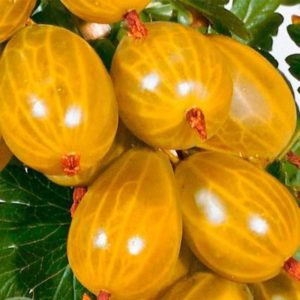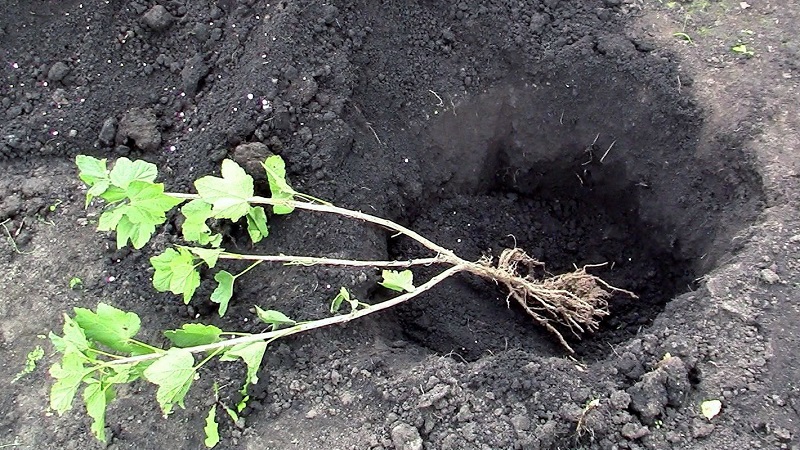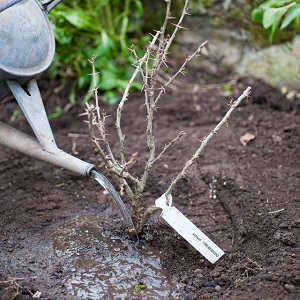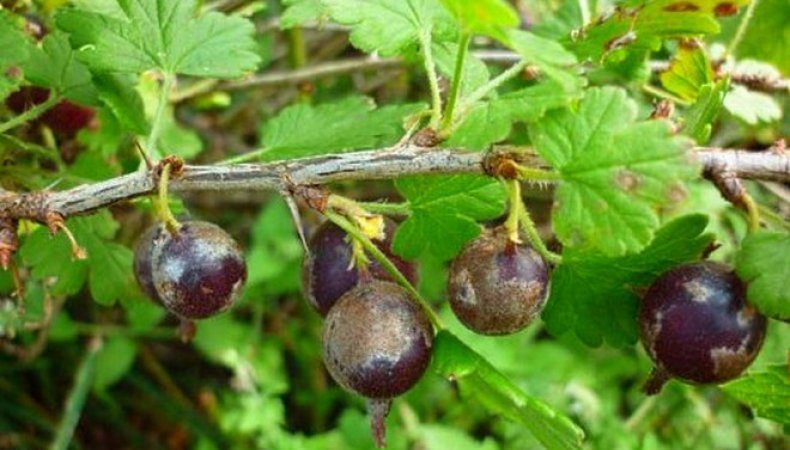Sweet frost-resistant gooseberry variety Amber
Gooseberry Amber is considered a proven variety. Its berries are sweet, with a honey smell. One large bucket of berries is harvested from one bush. The variety appeared in the 60s. XX century. It was bred by free pollination of English gooseberries. This unpretentious and frost-resistant plant is capable of developing normally in almost all regions of Russia. In the article we will give a detailed description of the Amber gooseberry variety.
The content of the article
Gooseberry variety Amber
Gooseberry Amber is not in vain so popular with gardeners. This plant is resistant to many diseases, unpretentious in care and produces berries with excellent taste.
History of origin and distribution
The Yantarny variety was developed by Russian breeders headed by M. Pavlova in the middle of the 20th century. It did not get into the State Register, but it has been preserved unchanged to this day. Many nurseries are now actively involved in the cultivation of this gooseberry and the sale of seedlings and fruits. It is also exported to many countries around the world.
Characteristics and description of the bushes

The main characteristics of the Amber gooseberry bushes:
- The plant reaches 1.5 m in height. The branches have rare but very sharp thorns. There are few leaves.
- Variety Amber early maturing. In the middle lane, the crop is harvested in early July.
- This gooseberry is very fruitful. About 10 kg of berries are collected from 1 bush.
Resistant to temperatures
All varieties of gooseberries are resistant to low temperatures, and Yantarny has improved these indicators. It is able to withstand frosts down to -40 ° C. In this case, the root system does not suffer at all, but shoots that have not been insulated may be damaged.
The variety is resistant to summer drought, tolerates long-term absence of watering and rain well.
Disease and pest resistance
This gooseberry is immune to most fungal diseases. It is also resistant to the invasion of various insects. Gardeners note that Amber does not get sick often and is rarely attacked by gooseberry aphids.
Characteristics and description of fruits
The berries of this variety have an oval shape and a yellow-orange color with light veins. The average weight of one berry is 6 g. The tasting score is 4.7 out of 5. The berries have a sweet taste with a slight sourness and honey aroma.
Harvesting takes a long time. Ripe berries do not burst or crumble, but stay on the branches for a long time.
Areas of use
Most often, Amber is consumed fresh. The breeders have created exactly the dessert variety, so its berries are suitable for preparing culinary delicacies. Jams, confitures, jams, compotes are made from it.
The flesh of the Yantarny gooseberry is dense, which allows you to harvest it for the winter. Also, the berries tolerate transportation well. Gooseberry leaves are harvested for making vitamin teas.
Advantages and disadvantages of the variety
Among the advantages are usually distinguished:
- Long term of fruiting.

- Good fruit transportability.
- After ripening, the berries continue to hang on the branches, do not crumble.
- When stored fresh, gooseberries do not spoil for a long time.
- Dessert berries are also suitable for making jams, jams, compotes.
Among the shortcomings, summer residents often note the following:
- The bushes are too sprawling, requiring constant pruning and installation of supports.
- The thorns, although rare, are very sharp. This creates problems during care and harvest.
- With prolonged exposure to high temperatures, the berries burst, therefore they are not very suitable for making compotes.
Growing technology
To obtain a large yield of gooseberries, compliance with the cultivation technology is required. Deviation from the rules is guaranteed to reduce the number of berries and reduce the rate of development of the bush.
Optimal conditions
2 weeks before planting, prepare the site. It is dug to a depth of 25-30 cm. Until the moment of planting, the earth is left in a loose state, removing the germinated weeds. Then the surface is leveled in order to carry out high-quality watering in the future.
Terms and rules of landing

Saplings are planted at any convenient time, except for winter. Many people think that the most suitable period is late autumn. So it is more likely that the plant will take root.
The site for planting is selected sunny, fertilized, protected from drafts. It is desirable that the soil is neutral, slightly alkaline or slightly acidic.
The distance between individual seedlings is maintained at 1.5 m, between rows - 2 m.
Further care

After planting, they move on to caring for the plants. The speed of development of the bush depends on the correctness of the various procedures. Care methods depend on the season and weather conditions.
In the spring make sure there are no weeds. They also carry out top dressing and regular loosening of the soil. In the summer, intensive watering is added to these actions. In the fall, gooseberries are prepared for the winter. The bushes are cut and insulated.
Young bushes are regularly watered with warm water: 2 times a week, one bucket for each plant. Water is poured under the root. In rainy weather, the plants are not watered, since the culture does not like excessively moist soil.
Gooseberries are fed annually. To do this, take 5 parts of humus and 1 part of ash. The mixture is scattered under the bush in a layer of 2-3 cm.
After harvesting, the soil is mulched with straw or sawdust. In the spring, this layer is removed, and the ground around the bushes is loosened.
In the first year after planting, formative pruning is carried out. It is required for the proper development of shrubs. In the second and third years, two-year-old shoots are cut in half. In the fourth year, the gooseberries are thinned out. At the same time, dried and weak branches are removed.
Powerful and spreading bushes are erected to support. Stakes are driven in around the gooseberry and tied with a dense rope. If the plant is planted near a fence, its branches are tied to a trellis.
Possible problems, diseases, pests

Most often, gooseberry affects powdery mildew... Define it the presence of white bloom on the leaves... After a while, it darkens. Ovaries and fruits are affected.
With anthracnose leaves are covered with brown spots. To treat this disease, several times during the summer, the plant is treated with Bordeaux liquid.
Mosaic appears as spots with a yellow tint. it disease is not treated, so the bush will have to be dug up and burned, and the site should be disinfected.
Among pests the gooseberry is parasitized by aphids, moths, leaf gnawers. To remove insects, the bush is treated with fungicides.
Wintering
When the crop is harvested, the plant is treated with Bordeaux liquid. After that, the bushes are dug in, fertilized and cut off. Then a layer of fallen leaves is poured, and additional insulation is laid on top - a dense agrospan.
Reproduction

Gooseberry propagated in two ways: by cuttings and planting layers.
In the first method, cuttings are prepared, which are cut from young shoots. The minimum length is 12 cm. Cuttings are cut in early May and immediately planted in a moist substrate. They are then watered regularly and protected from direct sunlight.
Planting cuttings is considered the most effective propagation method.This procedure is carried out in the middle of autumn, when the sap flow stops. On the bush, low-lying layers are chosen, bent to the ground and buried in. After germination, they are transplanted.
Features of cultivation depending on the region
The variety is known for its high vitality. For many years it has been grown in the middle lane. In the northern regions, they pay special attention to the bushes - they must be fed before wintering. In southern climates, the shrub is regularly watered abundantly.
The ripening period of berries varies depending on the region. In the southern regions, the crop is harvested in early July. In the western and eastern regions of Russia, this time is shifted to the end of the month or the beginning of August. In the north, gooseberries ripen by September.
Pollinating varieties
Gooseberry Amber is derived from the self-pollinated English variety, therefore it does not require additional pollinators on the site.
Reviews of summer residents
The variety has long been known to gardeners and has many positive reviews.
Karina, Anapa: “I chose gooseberries for a long time and settled on the Yantarny variety, because I wanted to combine all the best in one bush. The berries are sweet and very juicy. The plant gave its first fruits the next year after planting. The only problem is the need to constantly tie the branches. "
Anatoly, Moscow: “I have been doing gardening for many years. There are several varieties of gooseberries on the site, but the favorite variety is Amber. It is unpretentious to soil and watering. The berries are delicious. Every year my wife makes jam for the winter. "
Conclusion
Variety Amber is unpretentious to growing conditions, resistant to droughts and frosts. Also, the bushes rarely get sick and are attacked by pests. In order for the harvest to be large, they adhere to the elementary rules of care: the plant is watered on time, rejuvenating pruning is carried out and fed.